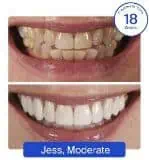Lingual braces use brackets hidden behind the teeth, making them almost undetectable. If you're considering dental braces for yourself or your teen, but are put off by the idea of visible “train track” braces, then lingual braces inside your teeth are a good option to consider.
There are many benefits of lingual braces vs traditional braces, but the main drawback is the cost. In this article, we'll explain how lingual appliances work and the different brands available in the UK, including Incognito.
We'll also look at what lingual braces cost in the UK and how you can lower the cost of your treatment.
You may want to look at the other options for inconspicuous teeth straightening too, for example comparing lingual braces vs Invisalign clear aligners or fixed clear braces. We hope this guide helps you understand more about hidden braces and whether they are right for you or your teen.
Lingual braces cost on average between £3,500 – £8,000 depending on what type of treatment you require and which dental practice you choose. We'll explain all the details in this article.
If you're looking for a more affordable alternative, you may want to consider Smile White aligners. These aligners are almost ‘invisible' and can treat 90% of cases. You can take their FREE smile assessment to see whether you're eligible, or read more information in our Smile White review.
Use “DENTALY5OFF” to save an additional 5% on your treatment.
Table of contents
What are lingual braces?
The term ‘lingual’ relates to the tongue and the surrounding area. Lingual brace brackets are placed on the back of the teeth, where the tongue rests, meaning they are hidden from plain view. Only if someone opened their mouth very wide would you notice that they were wearing these braces behind their teeth.
This makes lingual braces ideal for people who want to straighten their teeth without it being too obvious. This could be a teen who is worried about bullying or an adult who wants to maintain a professional look at work.
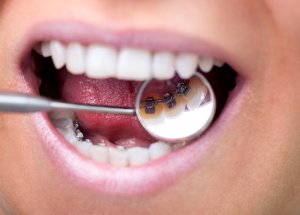

They are also popular for people who have a big day, such as a wedding, coming up. You can get a straighter smile without worrying about having a mouth full of metal in those all-important photos.
Hidden braces are very versatile as they can be used to treat a wide range of misalignment and malocclusion problems.
You may hear this type of brace referred to as ‘incognito braces’. Although this is actually a brand name, it has become synonymous with lingual braces in the same way that ‘Invisalign' has for invisible braces. We’ll talk more about Incognito lingual braces and other brands later on in this article.
Would you like to know what your teeth could look like after lingual braces (or indeed any kind of orthodontic work)? You can check for free using Invisalign's SmileView tool, even if you're not an Invisalign patient yet. Just upload a selfie, and you'll get your result in under a minute!
How do braces behind teeth work?
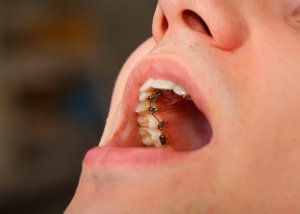

In much the same way as traditional braces, lingual braces use a wire and bracket system to gradually pull teeth into the desired position. The differences is they are hidden behind the teeth. You’ll need to visit your dentist every 6-8 weeks to have them tightened and adjusted.
Some types of lingual brace use standard brackets, but increasingly they are custom-made to fit each specific tooth.
Cleaning your lingual braces is hard. They are positioned closely together, which makes it
easier for the food particles to get stuck.
You can use a water flosser to really get in
between them and clean them.
Dr. Satish Pai, Brite Orthodontics
Custom-made braces can speed up treatment times and give your orthodontist greater control over results. They are also more comfortable to wear as they are typically slimmer than standard brackets. On the other hand, because each piece is made to order, custom-made braces behind teeth cost more than those with standard brackets.
In this incredible time-lapse video you can see lingual braces before and after from both the inside and outside of the mouth:
Can children wear lingual braces?
Children can wear lingual braces provided their teeth are large enough to affix the brackets to. However, there are other more affordable options which also let children straighten their teeth inconspicuously.
For example, Invisalign First is designed for early intervention in young children aged 6-10. And you can get Invisalign clear aligners for teenagers, which are usually cheaper than custom lingual braces.
Lingual braces pros and cons
We've already mentioned some of the main benefits of lingual braces, namely:
- Almost invisible brackets
- Can treat a wide range of cases
- Faster treatment time possible with custom lingual braces
But there are some significant drawbacks to consider as well:
- Longer appointments due to the precise adjustments and custom archwire needed.
- Discomfort because of proximity to the tongue. Although patients usually adjust well, tongue ulcerations are common at first.
- Hard to clean due to the position in the mouth. Cleaning around brace brackets is tricky enough when you can see them!
- Temporary lingual braces lisp since the brackets interfere with the position of the tongue when talking.
And the price… but we'll come to that later. First, let's look at some specific differences between lingual, traditional and invisible braces.
Lingual vs. traditional metal braces
Generally speaking, lingual braces cost more than traditional metal braces. This is especially true for those which are custom-made to fit each tooth. In addition to the manufacturing costs, they take longer to adjust at each checkup so you’re paying for more of your dentist’s time during the course of treatment.
Lingual braces work the same way that metal braces do, except they are fixed to the backs of teeth instead of the front.
While lingual braces are generally successful in orthodontic treatment, while also being discreet, they do present some problems. The biggest issue has to do with the tongue, as it can take a long time for your tongue to get used to the braces, and may result in irritation.
Eating can be more difficult as well with lingual braces. However, for many, lingual braces are well worth the trouble for both their efficacy and their invisibility.
Dr Yusupov, Amazing Smiles Orthodontics
In the UK, traditional braces are available on the NHS to qualifying under-18s and to adults with particularly severe cases requiring orthodontic treatment. But you won't get lingual braces on the NHS, or any other type that's just an aesthetic choice.
The British Lingual Orthodontic Society notes a further benefit of lingual appliances: any damage to the teeth is less visible than with traditional braces. It's possible for fixed braces to leave some plaque residue or white spots (decalcification) on the teeth due to poor oral hygiene. If this does occur while you're wearing braces on the back of your teeth, at least the damage won't be obvious.
What's the difference between lingual braces vs Invisalign?
If you’re keen to have braces that aren’t immediately noticeable, your two main choices are hidden braces on the inside of your teeth or invisible braces.


Invisible braces are a totally different way to straighten teeth without using any wires or brackets. Instead, they use a series of removable clear plastic aligners to gently guide the teeth into the desired position.
Aligner braces are not technically invisible, but they are hard to spot until you get very close. Braces on the back of teeth, however, are designed to be completely hidden unless you open your mouth very wide. You may also consider clear braces which, although noticeable close-up, are more subtle than traditional metal braces.
There are a number of benefits to Invisalign clear aligners which make them a good alternative to lingual braces:
- They are much less noticeable than metal braces
- The aligners are removable so it's easier to clean your teeth and braces
- There are no restrictions on what you can eat or drink (as long as you clean your teeth before replacing them)
- There are no metal parts that may hurt your tongue or cause mouth sores
- Invisalign doctors used advanced technology to plan and monitor your treatment for more precise results
- Invisalign treatment is generally cheaper than lingual braces
The severity of your tooth misalignment may affect the type of braces you can wear. Invisalign aligners are suitable for 90% of cases but if you have a very severe malocclusion you may need fixed braces.
To find out which category you fall into, take advantage of a free Smile Assessment. It takes just two minutes to enter your details and you can quickly find out whether you're a suitable candidate for this type of treatment.
If you'd prefer to discuss your treatment in person, find your nearest Invisalign provider.
Braces comparison
This table sums up the key information about lingual vs traditional vs invisible braces:
Type of brace | Lingual | Invisible aligner | Traditional metal |
Estimated cost | £1,500 - £10,000 | £1,500 - £5,500 | £1,500 - £3,000 |
Appearance | Hidden behind teeth; almost unnoticeable | Hard to notice; can be removed | Very obvious |
Suitable for | All cases | All cases | |
Typical treatment length | 12-18 months | 12-18 months | 12-18 months |
Appointment frequency | 6-8 weeks | 4-6 weeks | 6-8 weeks |
Appointment duration | 30 minutes | 15 minutes | 15 minutes |
Cleaning | Require special effort to clean properly | Can be removed to clean; teeth cleaned as normal | Require special effort to clean properly |
UK orthodontists offering this type | >35% | >75% | 98% |
As you can see, lingual braces can be much more expensive than other styles, and they require longer appointments. If you're looking for braces which are really hard to spot but don't cost as much as lingual braces, the Invisalign system is probably the best option for you. Read more about clear aligners in our removable braces guide.
Remember, if you're interested in Invisalign treatment you can take a free Smile Assessment online in just two minutes to verify that you're a suitable candidate.
Types of lingual brace
Once you have decided this is the type of brace you want, you’ll need to choose between different brands and styles available in the UK.
Incognito braces
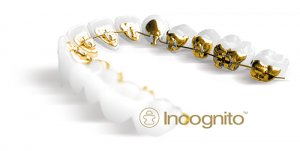

The brand Incognito manufactures its braces in Germany using advanced computer design technology. Each bracket is moulded to fit a specific tooth and is made as flat as possible. This means there is less chance of the braces interfering with speech or causing inflammation in the mouth.
Incognito lingual braces are made from a gold alloy which heavily reduces the chances of an allergic reaction.
In the UK Incognito braces cost anywhere from £4,000 for a full set. Other brands are available for less but each has its advantages and disadvantages.
The parent company, 3M, also manufactures Incognito Lite braces. These are a more cost-effective solution for patients who only need to have their front six or eight teeth straightened – they are around half the price of a full set.
Self-ligating lingual systems
Hidden brace wearers can take advantage of self-ligating technology with an archwire that automatically adjusts itself gradually. This leads to a more comfortable experience when compared to the traditional method of tightening every few weeks.
STb Light Lingual System, produced by Ormco (the company that makes Damon braces), is one of the self-ligating options available.
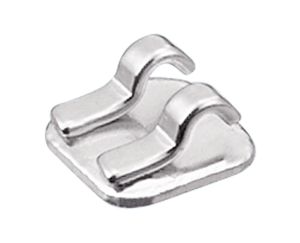

Non-custom systems
For patients who want the discreetness of hidden braces but can’t afford the high price tag of custom-made brands, there are options like Forestadent braces. This system is made in Germany from standardised parts and claims to be “the flattest lingual bracket in the world”. The brackets are fixed directly behind the teeth without any expensive laboratory customisation.
This cheaper style of lingual brace is best suited to patients with mild crookedness. For more complex orthodontic work, a custom-made brand will be more effective.
How much do lingual braces cost in the UK?
In straightforward cases with a standard brand, braces behind teeth cost £2,000 – £3,000 in the UK. Lingual braces can cost £10,000 or more for complex treatment with a custom-made brand.
Not every orthodontist is trained to carry out treatment with lingual appliances. It's usually a specialist area, and this means you're paying extra for the expertise required. Plus, with bespoke braces you're paying for the time and effort involved with shaping them to fit your teeth perfectly.
Prices for lingual braces in the UK (and any other private dental treatments) vary between different dental practices and area. Because of this, it’s worth looking beyond your local dental surgery as you research the price of lingual braces near you. Driving a little further could save you hundreds of pounds over the course of your treatment.
Do also consider that you will need regular checkups during your lingual orthodontic treatment, so you must factor in the cost and time involved with each trip to your chosen clinic.
When obtaining quotes, also check what level of aftercare is included in the price. This may or may not include follow-up visits and teeth retainers, which are needed to keep your teeth in their new position.
Ways to save money on hidden braces
Aside from shopping around in your local area, there are other ways you may be able to save money on your lingual braces.
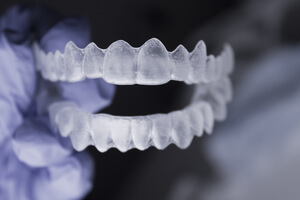

- Mix and match: Consider getting traditional braces on your lower teeth and lingual braces on the top only, since these are more visible when you smile.
- Go for a ‘lite' option: Some brands offer a treatment option which focuses on just the front 6-8 teeth. This will work out cheaper if you only need minor tooth correction.
- Consider a cheaper alternative like clear aligners: Invisalign aligners are not only cheaper than custom lingual braces, they are also more convenient since you can remove them to eat what you want and clean your teeth.
- Research different brands: We mentioned some of the better-known brands earlier, but others may turn out to be more affordable. Ask different dentists which brand(s) they recommend, and why.
- Spread the cost: Ask your dentist about payment plans, ideally with 0% interest. Or, look at a dental loan to make treatment more affordable.
- Dental insurance: Basic insurance plans usually only cover essential dental work, but if you have a premium plan you may be eligible to claim back some of your lingual brace costs.
Use “DENTALY5OFF” to get an additional 5% discount.
Getting fitted with braces behind teeth
Now let's look at what actually happens when you get lingual braces fitted inside your teeth.
The first thing your orthodontist will do is create an impression of your teeth. This is usually done using dental putty.
For braces that are being custom-made, your dental impressions are sent away to a laboratory where your braces are created. This process typically takes around six weeks, and then they are ready to be fitted.
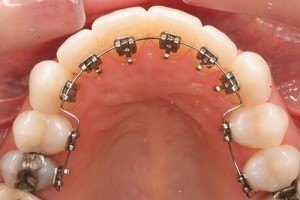

Your orthodontist uses a dental cement to securely affix each brace bracket to the correct tooth. Since fitting braces behind the teeth is quite a fiddly process, it might be spread over two visits.
You'll have regular checkups every six to eight weeks. At these checkups your orthodontist will check the progress of your treatment against the expected results.
He or she will then make adjustments to the wire connecting your brace brackets. The continued tension on your teeth keeps them moving in the right direction.
Because hidden braces allow you a clear view of your teeth, you'll be able to notice results more quickly – often within just a few weeks of beginning treatment.
It's normal for patients to experience some discomfort when they first get braces fitted behind their teeth, and it's quite common to have a lisp when lingual braces are first fitted. Orthodontic wax can be used to cover any parts which are irritating the tongue and paracetamol should relieve any achiness after initial fitting and subsequent adjustments.
Most treatments with behind-the-teeth braces take 12-18 months. For less complex cases it may be as quick as six months, while some cases can take several years.
How do I find lingual braces near me?
Fitting braces to the back of teeth is not as straightforward as the front; it requires special training and equipment. Therefore, not all orthodontists in the UK offer lingual braces.
The best way to find lingual braces near you is to check out some nearby dental practices or see if your usual dentist can refer you.
You'll probably find it easier to locate a dentist or orthodontist offering Invisalign treatment than one offering lingual braces. A 2018 survey by the British Orthodontic Society found that over 35% of orthodontists provide lingual braces while over 75% provide clear aligners. Almost all (98%) offer fixed braces on the front of teeth.
Lingual braces reviews
There are plenty of reviews of lingual braces available to read on online forums. You can also view endless video reviews on YouTube, which should give you a good idea of what to expect.
Here is one user sharing her experience with Incognito braces in the first few days after having them fitted:
She reports how using orthodontic wax helped immensely with easing tongue pain at this stage. She also describes how she had a meeting with her boss, who didn't seem to notice anything different.
On the second morning she found the aching worse than the first, and she was only managing to eat soup, yoghurt and smoothies. You can follow her progress in her other videos.
In a later review she gives some tips for life with lingual braces. She recommends you keep to hand:
- An electric toothbrush with a special orthodontic head
- Orthodontic wax and tissues to dry your mouth before applying it
- Interdental brushes
- Mouthwash and breath freshener
- Straws
Finally, if you want some honest lingual brace reviews, try asking around your friends and colleagues. Since these braces are so inconspicuous, someone you know may have had them without you even realising!
Don't forget, you can preview your straighter smile for free, using Invisalign's SmileView tool. Why not give it a try and see what you might look after treatment?
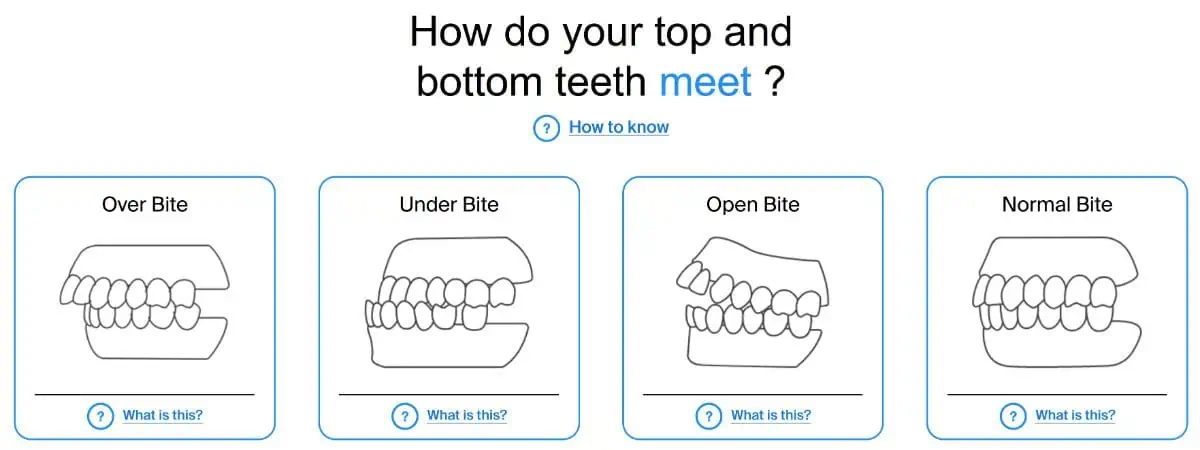

Conclusion
Lingual braces consist of brackets fitted to the back of teeth, next to the tongue, connected by a wire. The main reason people choose to get braces behind their teeth is so that nobody else knows they are wearing them.
While they are an effective way to straighten teeth, lingual braces in the UK cost more than most other types – particularly if you opt for a custom-made variety – and can be quite uncomfortable.
If you're looking for a cheaper alternative to lingual braces which is still almost impossible to detect, consider clear aligner braces. These are almost invisible and have the added benefit of being more comfortable than metal brace brackets.
Invisalign braces are suitable for 90% of orthodontic cases. It's easy to check if they will work for you – just take a quick Smile Assessment online. It's completely free and takes less than two minutes to complete.
If you discover you're an eligible candidate and want to find out more, you can book an appointment with your nearest Invisalign provider. At this consultation, you will receive a personalised quotation, which you can then compare to lingual brace prices.


- Virtually Invisible: Enjoy the discretion of clear aligners without brackets or wires.
- Home Convenience: Start from home with an easy assessment and custom aligner kit.
- Wear Time Flexibility: Optimal results with 22+ hours daily wear, changing aligners every 2-3 weeks.
- Cost-Effective: Save up to 75% compared to traditional braces.
- Safe Materials: BPA and latex-free for your health and comfort.
- Quick Results: See changes in just 4-6 months.
- Transform your smile today with NewSmile: Discover More
[/featured_box]
Getting lingual orthodontics or any other kind of braces is a big decision. We hope this article has helped you make up your mind about what's right for you.
FAQs
Can lingual braces fix an overbite?
Yes, lingual braces are suitable for all types of malocclusion and can treat pretty much the same range of cases as braces fixed to the front of teeth. You'll need to see an orthodontist to verify.
Do lingual braces affect speech?
After the brackets are first fitted, it's normal to experience a slight lisp while you adjust. Once you get used to them, there is rarely any lasting effect on speech. Because the brackets come into contact with the tongue, there is a greater chance of them affecting speech than with traditional braces.
What are braces on the back of teeth called?
The technical term for braces fixed behind teeth is ‘lingual braces'. With this style, the metal brackets are cemented to the back of the teeth to make them nearly invisible.
British Lingual Orthodontic Society: About lingual braces. Consulted 24th April 2019.
National Center for Biotechnology Information: Lingual orthodontic treatment duration: performance of two different completely customized multi-bracket appliances (Incognito and WIN) in groups with different treatment complexities. Consulted 24th April 2019.
Lenus, the Irish Health Repository: Lingual orthodontics: an illustrated review with the incognito fully customised appliance. Consulted 24th April 2019.
National Center for Biotechnology Information: Comparison of speech performance in labial and lingual orthodontic patients: A prospective study. Consulted 15th October 2020.
Prices stated are indicative only and are based on publicised treatment prices at dental clinics across the UK.





